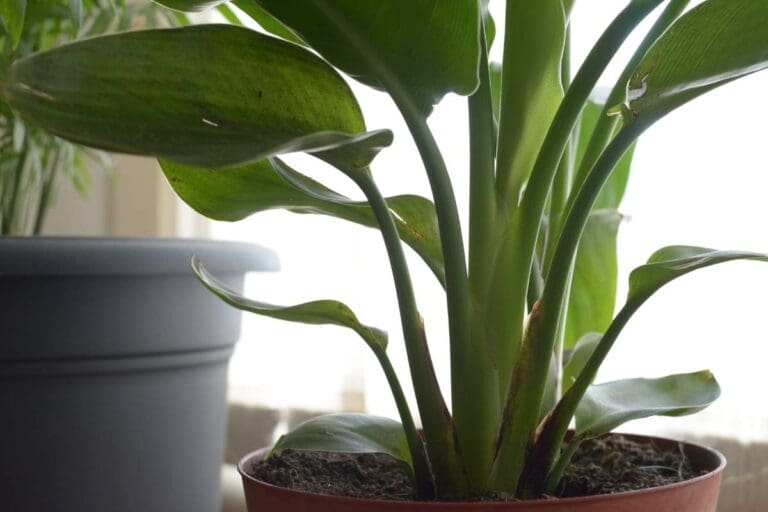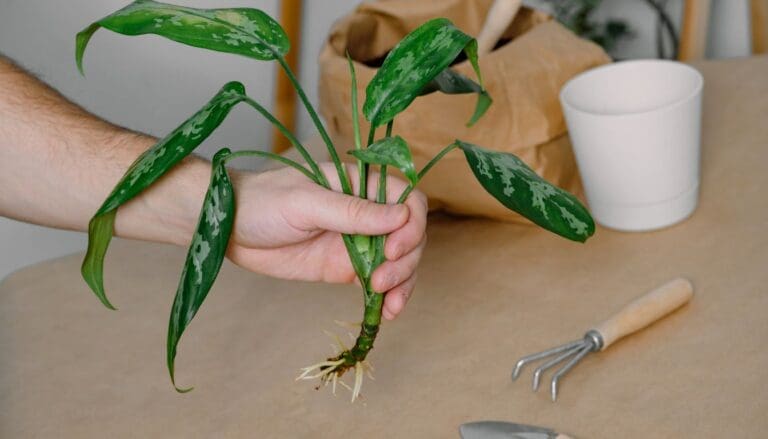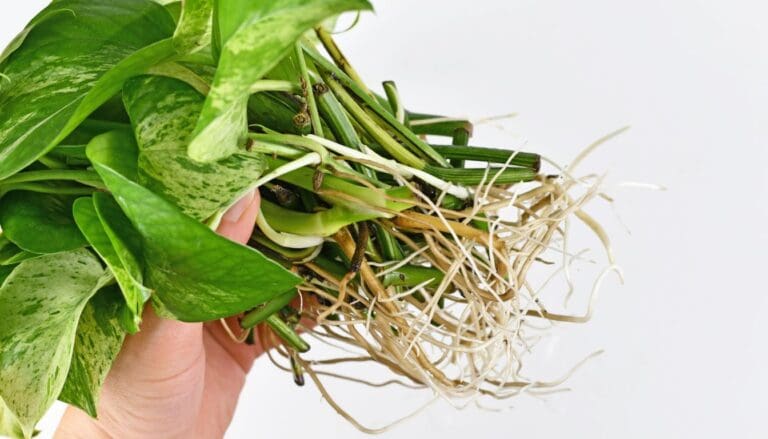12 Care Tips For Calathea Plant (Don’t Miss No.7)
Calathea, also called the Prayer plant, is a beautiful tropical species loved for its patterned leaves and unique leaf movements.
Although it is not unusual for Calathea to develop problems due to even slight changes, you can master the art of growing Calathea with some knowledge about its care.
Calathea grows in the forest bed of the tropical rainforests where it gets dappled sunlight, so you must try to mimic that by providing it indirect sunlight. Calathea requires moist soil all the time, so you shouldn’t let the soil go bone dry or even soggy. Fertilize it during the growing season and not during winter.
For more such tips that will keep your Calathea happy, read this article as we have mentioned all the care tips your Calathea needs to stay alive, healthy, and happy.

Please note: Simplify Plants is reader-supported. Some links in the post are affiliate links and I get a commission from purchases made through links in the post.
How do I keep Calathea happy?
Here are 12 tips that can help you keep your Calathea happy and healthy.
1. Provide 8-10 hours of indirect sunlight and no direct sunlight.
If you have heard that Calathea is a low-light plant, you are not wrong. But that is not the ideal condition for this species.
Calatheas come from tropical rainforests where they get dappled sunlight under the canopies. Its requirements don’t change when you grow it indoors.
You must provide 8-10 hours of indirect sunlight to your Calathea by placing it near a south-facing window if possible.
Direct sunlight is a big no for Calatha plants as the exposure can cause instant damage by scorching the leaves, drying out the soil, and dehydrating the plant.
If you think your Calathea is getting direct sunlight, you can create filters by using curtains or blinds on the window so that the plant only gets indirect sunlight.
And in case your house doesn’t get enough natural sunlight, use artificial lights and place your Calathea beneath it.
Also read: How Much Light Do Calathea Plants Need? (Calathea Plant Light Requirements)

2. Don’t forget to provide enough darkness to your Calathea.
When using artificial light, you might forget to turn it off, but too much light will not be suitable for your Calathea either.
Calathea doesn’t require more than 16 hours of light as it also needs 8 hours of darkness.
During darkness, the leaves of Calathea close up. This resembles praying, which is why Calathea is called a Prayer plant. This phenomenon is necessary for Calathea, so you must not deprive it of darkness.
Calathea also respires more in the darkness that helps it transfer the energy created during photosynthesis to all its parts.
Also read: Is My Calathea Getting Too Much Sun? (Sunburnt Calathea)
3. Keep the soil moist.

Calathea is very particular about its water requirements, and it will neither withstand waterlogged nor bone dry soil. So, you must water your Calathea when the top 25% of it dries out.
Since Calathea doesn’t prefer waterlogged soil, check the soil’s moistness before watering it so that you don’t overwater it. Calathea is sensitive it overwatering and will develop yellow leaves as soon as it starts experiencing overwatering.
You must also not allow your Calathea to experience draught-like conditions, so don’t keep it thirsty for too long. You can maintain a calendar so that you don’t forget to water it on time.
Make sure that the soil has sufficient retaining and draining elements in the soil. You can prepare an easy and ideal soil recipe for your Calathea by mixing 2 parts potting soil, 1 part orchid bark, and 1 part perlite.
Also read: What Kind Of Soil Is Best For Calathea? (Best Soil Mix For Calathea)
4. Calathea loves high humidity, so don’t let it go too low.

Similar to other tropical plants, Calathea also prefers high humidity, which allows it to thrive.
In its native land, Calathea gets 70% or more humidity. We understand that providing that much humidity might not be feasible for you indoors, but you must not let it go below 50%.
- You can keep the humidity on the higher side by using a humidifier. Install a humidifier near your Calathea or keep it in the room that has one already.
- You can also use a pebble tray. Take a tray and place some small stones on it. Fill the tray with water and place the Calathea on the stones. The water will dissipate from the tray and provide humidity to your Calathea.
- The easiest way is to move your Calathea to the bathroom as this room has a more humid condition than the other rooms.
Also read: Should I Mist My Calathea Plant? (Calathea Humidity Requirements)
5. Keep your Calathea in warm temperatures.
In the tropical rainforests, Calathea gets warm temperatures, which it needs, making it suitable for indoors.
If you keep Calathea outside, you might see it getting stressed due to temperature fluctuations or low temperatures.
When you keep the Calathea indoors, it will be under controlled temperatures. Try to keep the temperatures between 65-80°F.
If the temperatures drop below 60°F in winter, you can place your Calathea in a warmer room with a fireplace or furnace. However, never keep the Calateha too close to any heating source as it can make the plant dry.
- Keep your Calathea away from windows and doors that are opened and closed often.
- Keep your Calathea away from cold drafts and low temperatures.
- Keep your Calathea away from the direct air coming out of the AC.
- Don’t keep your Calathea near frosty windows.
Also read: What Temperature Can Calathea Tolerate? (Ideal Temperature Range)
6. Fertilize Calathea only during the growing season.

Calathea doesn’t require a lot of fertilizer, and since it is a fussy plant, giving it more fertilizer will only cause damage.
You must fertilize your Calathea during the growing seasons, which are spring and summer. Use a well-balanced 10:10:10 fertilizer and fertilize the plant once a month or once in 20 days.
If you notice brown tips or edges on the leaves, your Calathea might be showing signs of overfertilization. You must either reduce the frequency or the amount of fertilizer you are giving the plant.
Consider diluting the fertilizer to make it half-strength before applying it to your Calathea.
One crucial point is that you must avoid fertilizing your Calathea during the winter months, the dormant period when the plant rests. It won’t require any fertilizer as it won’t grow.
Also read: Should I Fertilize Calathea? (How Often+Best Fertilizer)
7. Keep your Calathea leaves clean.
Keeping the leaves clean is crucial for all plants, including Calathea but this often goes overlooked, especially by busy plant owners.
You might be misting your Calathea to increase the humidity. It is a great way to keep the leaves clean.
After misting the leaves, wipe them with a clean cloth to remove all the accumulated dust. This will ensure that the plant can photosynthesize properly.
Keeping the leaves clean will also ensure that the leaf movements of the Calathea are uninterrupted.
8. Water your Calathea with good quality water.

Among all other factors, Calathea is also sensitive to harmful minerals such as chlorine, fluorine, etc. These are usually found in tap water.
So, if you’ve been watering your Calathea with regular tap water, you might notice that the leaves might develop spots.
So, you need to change the water you are using. You can leave tap water outside for a night and let the harmful minerals dissipate into the air, or you can use filtered water or rainwater while watering your Calathea.
Also read: How Often To Water Calathea? (A Complete Calathea Watering Guide)
9. Repot your Calathea only when required.
Calathea doesn’t enjoy too much disturbance or too many changes. It has delicate roots, so repotting too often can damage the roots.
You should repot your Calathea plant only when required, i.e., only if it gets rootbound.
Calathea doesn’t prefer being in a rootbound state, so you should repot the plant if you find roots emerging from the drainage holes or showing over the soil.
The ideal time to repot your Calathea is during spring, as this is when it gets the ideal growing conditions to recover from the repotting stress faster.
However, if you notice any disease like the root rot disease, you can repot your Calathea in any season as repotting is necessary to save the Calathea from root rot.
Also read: When To Repot Calathea? (+Step-By-Step Guide)
10. Keep spider mites and other pests away from your Calathea.
Pests are a nuisance that can immensely affect the health of your Calathea. So, you must protect your Calathea from pests by preventing them.
Calathea is most prone to spider mites, and they prefer dry areas. Keep the soil moist if you want to protect your Calathea from spider mites.
However, other pests like mealybugs and aphids might attack your Calathea if you make the soil soggy. So, don’t overwater or underwater your Calathea.
The next thing you must do is spray a neem oil solution all over your Calathea once a month. This will prevent pest infestation on the plant.
Also read: Do Calathes Attract Bugs? (Common Pest+Solution)
11. Prune your Calathea to get rid of dead and damaged leaves.

You might not need to prune your Calathea too often like many other plants. But, you must prune your Calathea whenever you notice damaged, diseased, or dead leaves and stems.
Use sterilized pruners to prune the yellow or brown leaves at the base of the joins. Make clean cuts with sharp pruners.
Pruning the damaged leaves will allow Calathea to focus on new growth.
Also read: Why Has My Calathea Stopped Growing? (Possible Problem+Solution)
12. You can propagate your Calathea to get new ones.
If you have understood the art of growing a Calathea, you might want more of them in the house. You can do that by propagating instead of buying new ones.
You can’t propagate your Calathea by cutting a stem or leaf, but you can do it by dividing the plant. Gently pull your Calathea out of its pot and divide the root system and the plant.
Then repot the plants into different pots with fresh potting mix.
Also read: How To Propagate Calathea? (Best Time+Steps To Follow)
Final words
Calathea is a beautiful plant that can be demanding with its requirements. But if you understand its requirements and care for it accordingly, you can keep it happy without too much effort.
8-10 hours of indirect light, timely watering your Calathea to keep the soil moist but not soggy, and fertilizing during the growing season will keep your Calathea happy. I have mentioned a few more tips that will help your Calathea grow and stay healthy.
Also read: How To Save A Dying Calathea Plant? (Possible Problem+Solution)
Source: NCBI, University of Florida, Wikipedia, Growing Indoor Plants with Success, Agriculture, and Natural Resources, University of California, Missouri Botanical Garden.
Recommended Garden Supplies
| Product Image | Our Recommended Gardening Supplies | Check Offers! |
|---|---|---|
Top Top
Top
Top
Top
Top
Top
Top
Top | rePotme Houseplant and Tropical Classic Potting Soil Mix | Check Offer On Amazon |
 Top
Top
Top
Top
Top
Top
Top
Top | Espoma Organic Indoor Plant Food | Check Offer On Amazon |
 Top
Top
Top
Top
Top
Top
Top
Top | GooingTop LED Grow Light 6000K Full Spectrum Clip Plant Growing Lamp | Check Offer On Amazon |
 Top
Top
Top
Top
Top
Top
Top
Top | Soil Moisture Meter | Check Offer On Amazon |
 Top
Top
Top
Top
Top
Top
Top
Top | Govee Hygrometer Thermometer, Bluetooth Enabled! | Check Offer On Amazon |
 Top
Top | LEVOIT Humidifiers for Large Room(Best For Plants) | Check Offer On Amazon |
 Top
Top
Top
Top
Top
Top
Top
Top | Upgraded DIY Automatic Drip Irrigation Kit, 15 Potted Houseplants Support | Check Offer On Amazon |
 Top
Top
Top
Top
Top
Top
Top
Top | Stainless Steel Heavy Duty Gardening Tool Set | Check Offer On Amazon |
 Top
Top
Top
Top
Top
Top
Top
Top | Bonide Insecticidal Soap | Check Offer On Amazon |
 Top
Top
Top
Top
Top
Top
Top
Top | Bonide 32 oz Spray Neem Oil for Organic Gardening | Check Offer On Amazon |
 Top
Top
Top
Top
Top
Top
Top
Top | Garden Safe Fungicide | Check Offer On Amazon |






I love your writing style genuinely enjoying this website .
Hi there. I received a prayer plant from my mom maybe last summer and it seems to be healthy but I have a question about it. It seems to be growing outwards instead of upwards. Is this a normal thing for them to do? Do you have any advice and suggestions about what I can do to help with this?
Hey there!
Absolutely, it’s normal for prayer plants to grow outward rather than upward, as they tend to spread their leaves horizontally. To encourage more vertical growth, you might consider providing a support like a moss pole or gently staking some of the stems. Also, ensure it’s getting adequate indirect light, which can sometimes promote more upright growth. Keep enjoying your plant’s unique character – they’re such a delightful addition to any space!
Happy planting! 🌿✨
I just read the above re calathea
I previously have had them with an appearance you picture above.
Now I purchased one that I had no idea was the “prayer plant”. It has fatter
broader leafs, and the is a pink/purple / tinge rather than a red one, but a red line down the center. It is growing fine in western indoor light, set back from the full sun.
However, recently I noticed a white cover over the top of the soil which
perhaps is a disease. Yet the leaves are growing. It could be I did not let it
dry out enough before wateringl…OR, it that I am not following any pattern
re when I water with plant food in the water, or not. Any ideas—no website.
I’m in DC so it is just getting warm—then will be hot, hot, how is it with air conditioning, I have only had it in the winter and spring period.
Thanks in advance
Thanks for sharing! The white cover on your soil is likely a harmless mold or mineral buildup from moisture. Try letting the soil dry out more between waterings and remove the top layer if needed. Calatheas do well with consistent moisture but don’t like soggy soil. In hot weather and with AC, keep humidity up and avoid cold drafts. Your plant sounds happy overall—just adjust watering a bit and it should thrive!